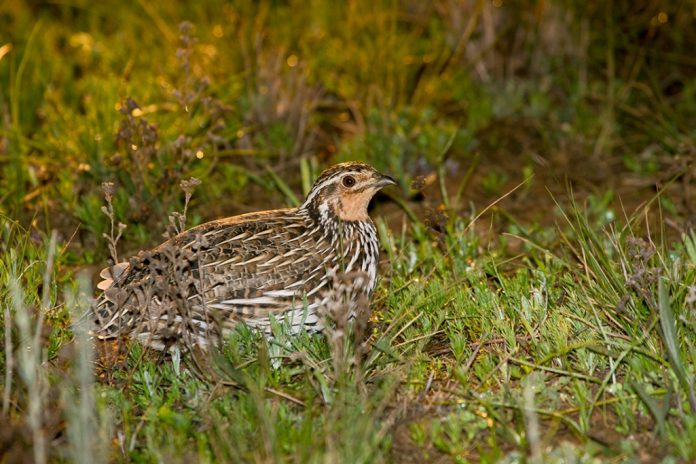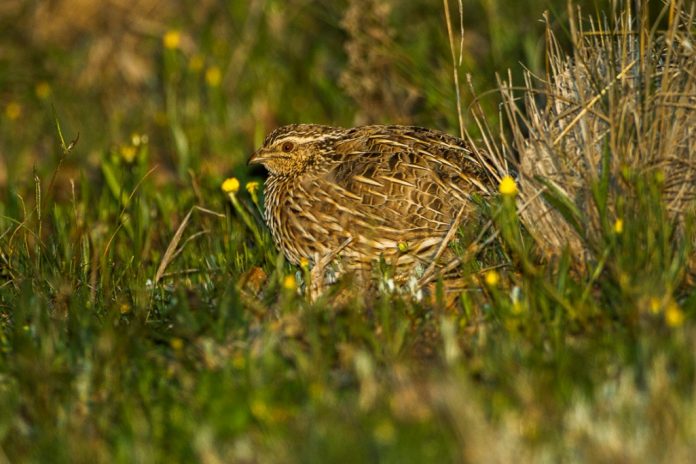Stubble Quail (Coturnix pectoralis) is the best-known Australian quail. The Stubble Quail is widespread in most pastoral districts, replacing the Brown Quail in the drier, more open grass fields there. Human settlement has had a mixed effect on its abundance. In coastal regions, the clearing of forest and woodland for pasture and crops has increased its habitat; but inland the savanna and grass plains that were and still are-core shelter have been degraded by sheep and rabbits. Despite its abundance, the Stubble Quail is seldom seen. One reason is its cryptic behavior.
Like all quail, it is a plump, round-winged, stump-tailed bird that lives on the ground and prefers to squat in grassy cover rather than fly or run when disturbed. There its mottled plumage camouflages it in actual fact. Only when almost trodden on will it burst from the grass in a clatter of wings and dash swiftly away in direct whirring low flight for 50 meters or more before dropping and running off quickly at an angle. Another reason why Stubble Quail are not habitually seen is their nomadism.
Although they do eat some insects and caterpillars, their staple diet is seeds, particularly waste grain in stubble fields and those from annual pasture weeds. These quail follow around most of southern and eastern Australia as they become ripe, and move inland whenever rain brings on herbage there; banded birds have been recorded traveling at least 1350 kilometers, from near Adelaide to Gunnedah, New South Wales. The quail do not travel in flocks but individually, building up in an area and then dispersing again as the food supply dwindles.
Much feeding is done at night. Stubble Quail is centered in southern Australia and breed mostly in spring when the ripening of the seeds of annuals peaks, and may raise several broods in succession. To start, the female scratches out a shallow scrape for the eggs while her mate calls or crows to advertise their nesting territory. He does this mostly at dawn and dusk, but also during the day and on moonlight nights for hours at a time.
The eggs are laid at 48-hour intervals. As soon as the chick is hatched, they leave the nest to be guarded closely, brooded, and led by parents in scratching for food. In about six weeks they are fully feathered and about two-thirds have grown and they can fly well. From then on, parents force them to leave, which they frequently do in male or female groups. Pairs form in the following spring, probably for life.
Stubble Quail is about 185-195 mm in length. However, the male quail’s upper parts are generally fawn brown with dusky blotches and clear cream stripes in the center of each feather. The Head and nape are dusky, with a white line down the center of the head and a white stripe above each eye extending co nape. Throat and lace light chestnut. Black center on breast; rest of breast and belly white, streaked black.
The eyes are red-brown, along with the bill gray-horn and the feet are yellow-buff. Thus, the female bird differs from the male in the throat is off-white, and its face and neck are pale buff with dark flecking; dusky-flecked breasts without a black center. The immature is just like a female, but downy young buff, with central black dorsal stripes from crown to tail and a lateral pair on the sides of the back.
The call of Stubble Quail is three-syllable clear whistle cuck-ee-whit or sharp, clear too-weep, by breeding male; also deep purring. The nesting and breeding seasons are mainly August-February; year-round in northern inland if the rain continues. Nest a scrape in the ground lined with a little grass; in comparatively chick cover. Eggs: seven to fourteen; which are pale creamy buff, uniformly covered with irregular freckles and blotches of umber or dusky; oval to pyriform, about 30 x 24 mm.
The incubation period is about 21 days, for females. The distribution of Stubble Quail is in open country and better-watered parts of southern Australia north to the Pilbara, Alice Springs, and central Queensland. Nomads appear at times in the upper Northern Territory and elsewhere beyond their normal range. Formerly in Tasmania, but now extinct. No races.


